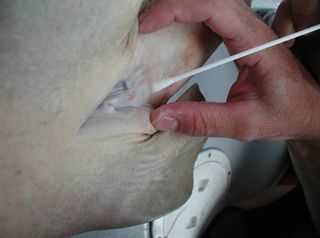Sharks Incubators for Drug-Resistant Bacteria

Even the monstrous Jaws might look tame compared to the swarm of antibiotic-resistant bacteria found in sharks and redfish, according to a new study.
The bacteria don't harm the toothy fish, but scientists worry that the sharks and redfish may become incubators for nasty multidrug-resistant strains, which could possibly infect humans someday. The exact sources for the antibiotic-resistant microbes remain unknown.
"It's not unexpected to find some drug resistance, but we were surprised to find the amount of resistance to that large suite of drugs," said Jason Blackburn, a spatial ecologist at the University of Florida in Gainesville.
Sharks swimming off the Florida Keys and Belize were hosts to bacteria resistant to the antibiotics amikacin, ceftazidime, chloramphenicol, ciprofloxacin, doxycycline, penicillin, piperacillin, sulfamethoxazole and ticarcillin.
By contrast, fish found off Martha's Vineyard in Massachusetts and in offshore Louisiana appeared to have the fewest number of antibiotic-resistant strains.
The study lacked large enough sample sizes to statistically compare different fish populations of wild sharks such as nurse sharks and bull sharks, as well as redfish popular among sport fishermen, but it still found bacteria resistant to 13 antibiotics in all among the sampled fish. That likely represents an underestimate of true drug resistance, the researchers said.
Just how the sharks and redfish acquired their antibiotic-resistant bacteria remains unclear. Humans may have reason for concern if some of the bacteria built up over time from the animals feasting on fresh seafood.
Sign up for the Live Science daily newsletter now
Get the world’s most fascinating discoveries delivered straight to your inbox.
"These species that we've targeted, these are apex or top-end predators in a similar position in the marine food web as we are," Blackburn told LiveScience. [Gallery of Endangered Sharks]
Blackburn conducted the work alongside other researchers as his master's thesis while studying at Louisiana State University in Baton Rouge. The study is now detailed in the June issue of the Journal of Zoo and Wildlife Medicine.
Finding the source
Researchers want to begin tracking down the source of the antibiotic resistance in various locations, even if the top predators don't suffer any ill effects so far from playing host to the bacteria.
"Either their food source had directly ingested drug-resistant bacteria, or bacteria in the [shark] gut were exposed to antibiotic components," Blackburn explained.
Sharks sampled off the Florida Keys ended up showing the greatest resistance to a wide selection of drugs. But different locations may have different routes for exposure to antibiotics or antibiotic-resistant bacteria.
Some of the antibiotic resistance may come from exposure to sewage. For instance, Blackburn and his colleagues noted an overflowing septic tank problem at the Dry Tortugas islands of the Florida Keys.
Sharks could also get their exposure to antibiotics directly from the humans popping the pills. Tourists in Belize often get right into the water to swim with or touch the relatively docile nurse sharks that were part of the study.
Age could make yet another difference, because the elderly redfish sampled had significantly greater drug resistance compared with younger spinner sharks that fed on the same fish. Both fish were sampled in Louisiana waters near offshore oil rigs.
Swimming with sharks
A next experiment might look more closely at age and antibiotic-resistance within the same individual fish over time, Blackburn said.
Slow-moving nurse sharks may prove ideal for the next experiment. The bottom-feeders browse for crustaceans and small fish, and also allow humans to interact with them for capture or tagging purposes. One nurse shark study at the Dry Tortugas has already reached its second decade.
Blackburn and his colleagues also went out several times with a park ranger or tourist boat at the Hol Chan Marine Reserve in Belize. They would swim out and grab an approaching nurse shark, turn it upside down and then allow a fellow scientist to swab the shark's genital region.
By contrast, capturing a faster shark requires longlines, rod and reel or gillnets.
"The bull sharks and spinner sharks have very low recapture rates when you tag and release one, so you'd have to bring [them] into captivity," Blackburn pointed out. "Nurse sharks provide a nice model because you can go get them again."
The researchers hope to include more sharks in any future studies so that they have larger sample sizes, and they also want to identify the antibiotic-resistant bacteria by species.
"Knowing that this pool of drug resistance is out there, certainly we've presented enough evidence to argue for more routine sampling," Blackburn said. "The survey showed resistance everywhere we looked, even in remote areas."
- Shark Science on the 35th Anniversary of Jaws
- 10 Reasons Great White Sharks Are Great
- On the Brink: A Gallery of Wild Sharks

